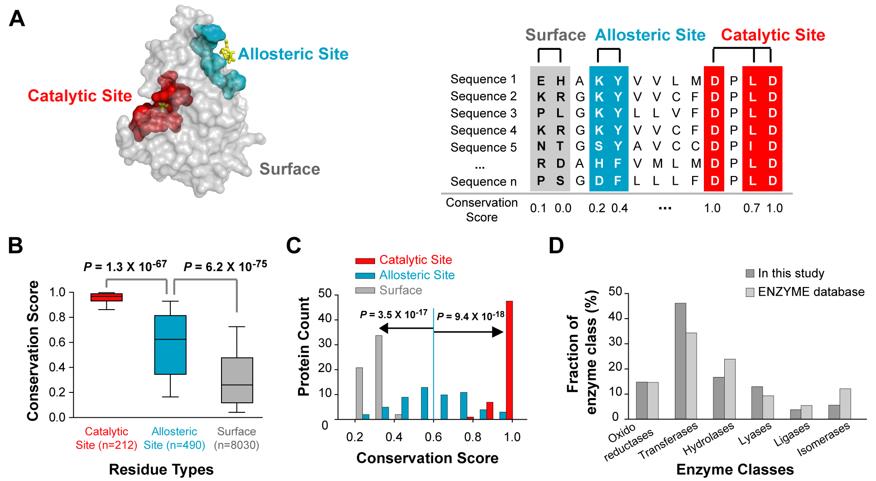Allosteric Regulation Engineering is a focused field dedicated to unraveling the complexities of enzymes. It entails modifying enzymes to adjust their reaction to molecules binding at sites beyond their active sites—an essential process known as allosteric regulation. This mechanism underpins many biological functions and carries considerable significance across multiple industries. By influencing enzyme behavior, we can leverage them for various practical purposes, such as drug discovery, biochemical production, and disease treatment.
 Rational engineering of enzyme allosteric regulation through sequence evolution analysis (Jae-Seong Yang, et al., 2012)
Rational engineering of enzyme allosteric regulation through sequence evolution analysis (Jae-Seong Yang, et al., 2012)
Technical Route
Here is the technical route for Allosteric Regulation Engineering. The technical route for Allosteric Regulation Engineering is methodical and precise, designed to ensure accuracy and success in our work. Each step in this process is vital, paving the way towards fruitful outcomes.
| Step Name |
Objective |
Description |
| Identification of Target Enzyme |
Select relevant enzymes for engineering based on applications |
Select the enzyme of interest that is relevant to a specific application or industry and select the enzyme based on its potential use and suitability for the desired process. |
| Understanding Allosteric Regulation |
Study allosteric regulation mechanisms in target enzymes |
Investigating the allosteric regulatory mechanisms of specific enzymes and examining the binding of molecules to allosteric sites to influence enzyme activity offers valuable insights for subsequent engineering efforts. This comprehensive study enables a deeper understanding of how enzymes are modulated by allosteric interactions and provides a foundation for further advancements in enzyme engineering. |
| Designing Modifications |
Design modifications to alter enzyme's response to allosteric molecules |
Based on the comprehension of allosteric regulation mechanisms acquired in the preceding stage, modifications are devised to adjust the enzyme's reaction to allosteric molecules. These modifications may employ techniques such as site-directed mutagenesis to achieve the desired alterations. |
| Experimental Validation |
Validate designed modifications through laboratory techniques |
Designed modifications are introduced into the enzyme through laboratory techniques such as cloning modified enzyme genes into expression vectors. Modified enzymes are then subjected to rigorous biochemical assays to evaluate their altered allosteric properties. |
| Application and Scaling |
Apply engineered enzyme to practical applications |
Once the engineered enzyme demonstrates desired properties, it can be applied to various practical applications such as industrial processes or drug development. Scaling up production methods to meet commercial demands is considered, ensuring desired properties are maintained. |
Service Process
Our Allosteric Regulation Engineering is designed to be comprehensive, thorough, and tailored to each client's specific needs. We ensure that our clients are involved and informed at every stage of the process:
- Initial consultation and project scoping: We begin by discussing your needs and potential projects. This helps us to define clear goals, set realistic expectations, and establish a roadmap for the project.
- Enzyme assessment and modification design: Our team conducts a thorough assessment of the chosen enzyme. We then design modifications, using state-of-the-art technology and methodologies.
- Modification implementation: The modifications are seamlessly implemented using advanced techniques. Our team of experts ensures that the changes are accurately introduced.
- Testing and refinement: We thoroughly test the modified enzyme, assessing its performance and effectiveness. Refinements are made as necessary, ensuring we meet and exceed project goals.
- Final report and project wrap-up: We provide a comprehensive report of the project, detailing the process, the modifications made, and the final outcomes. This ensures you are fully informed and satisfied with the project results.
We're here to assist you. If you have any questions, need more information, or would like to discuss a potential project, please don't hesitate to contact us. Our team is always eager to help and share our expertise.
Applications
The power of Allosteric Regulation Engineering can be harnessed in various fields. This includes pharmaceuticals, biotechnology, agriculture, environmental science, and many others. Our team, equipped with the knowledge and expertise to apply this technology, can serve a wide range of industries.
| Application |
Description |
| Metabolic Engineering |
Manipulating enzyme activity through allosteric regulation enables fine-tuning of metabolic pathways for enhanced production of desired compounds. This approach is pivotal in biotechnology for optimizing yields of biofuels, pharmaceuticals, and other valuable chemicals. |
| Drug Discovery |
Allosteric regulation engineering offers a promising avenue for drug discovery by targeting allosteric sites on enzymes involved in disease pathways. Modulating enzyme activity through allosteric regulation can lead to the development of novel therapeutic agents with improved efficacy and reduced side effects. |
| Biocatalysis |
Allosteric regulation engineering enhances the catalytic efficiency and substrate specificity of enzymes used in biocatalysis. This enables the design of tailor-made enzymes for specific industrial processes, such as bioremediation, food production, and chemical synthesis. |
| Biosensor Development |
Leveraging allosteric regulation in enzyme design facilitates the development of biosensors for detecting various analytes. By coupling enzyme activity with signal transduction mechanisms, biosensors can offer rapid, sensitive, and selective detection of target molecules for applications in healthcare, environmental monitoring, and food safety. |
| Therapeutic Protein Engineering |
Allosteric regulation engineering can be employed to modulate the activity of therapeutic proteins, such as antibodies and enzymes used in enzyme replacement therapy. This approach enhances the pharmacokinetic properties and therapeutic efficacy of protein-based therapeutics, improving patient outcomes. |
FAQs
We understand that Allosteric Regulation Engineering may raise a lot of questions. That's why we have compiled a list of frequently asked questions about this topic. If you don't find the answer you're looking for, feel free to reach out to us.
Q: What is the first step in your allosteric regulation engineering service process?
A: The first step of our service process involves an initial consultation and project scoping. We discuss your specific needs and potential projects to define clear goals, set realistic expectations, and establish a project roadmap.
Q: How do you ensure the safety of the enzyme allosteric regulation engineering process?
A: Safety is our topmost priority. We adhere to stringent safety guidelines and regulations in all our procedures. Our team is highly skilled and experienced in handling these procedures, always ensuring the maximum safety.
Q: Could you explain what an allosteric site is?
A: An allosteric site is a specific, non-active area on an enzyme where a molecule can bind. This process can cause a conformational shift in the enzyme, which results in a change in its activity. This change could either enhance or inhibit the enzyme's function, depending on the molecule.
Q: Can you describe how Enzyme Allosteric Regulation Engineering work?
A: Enzyme Allosteric Regulation Engineering is a complex and innovative process. We utilize advanced computational biology and protein engineering techniques to modify the allosteric sites of enzymes. By doing so, we can effectively alter their activity, enabling us to control the enzymes in a way that best suits the needs of the cell or organism. This approach holds great potential for creating tailored solutions in various fields, including medicine and environmental science.
Q: How is the modification of enzymes done in the service process?
A: Modification of enzymes is done carefully using advanced techniques. After a comprehensive assessment and design phase, the modifications are accurately introduced to the enzyme, altering its behavior for the desired output.
Q: What happens after the enzymes are modified?
A: Following the modification, rigorous testing is conducted on the modified enzyme. We assess its performance and effectiveness, and refinements are made as necessary to ensure optimal performance and precision.
Q: What can I expect at the end of the service process?
A: At the end of the service process, we provide a comprehensive report detailing the entire process, the modifications made, and the final outcomes. This ensures you are fully informed about the project results and satisfied with the service provided.

































 Rational engineering of enzyme allosteric regulation through sequence evolution analysis (Jae-Seong Yang, et al., 2012)
Rational engineering of enzyme allosteric regulation through sequence evolution analysis (Jae-Seong Yang, et al., 2012)